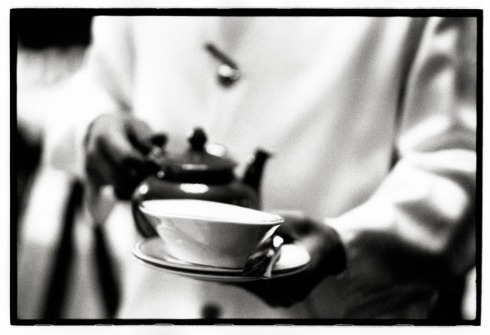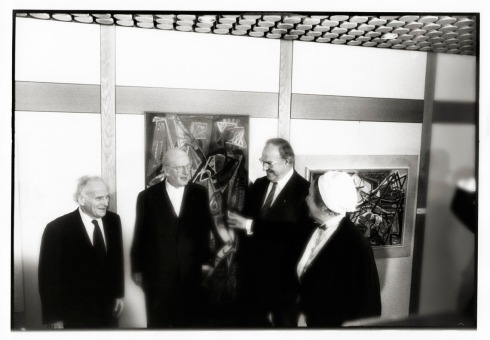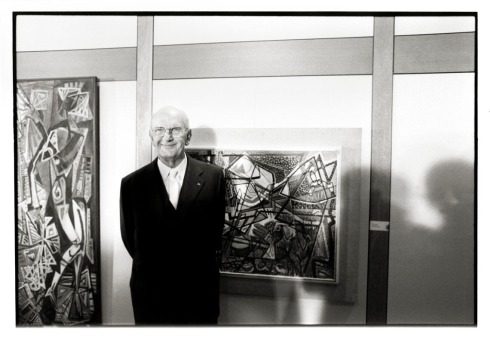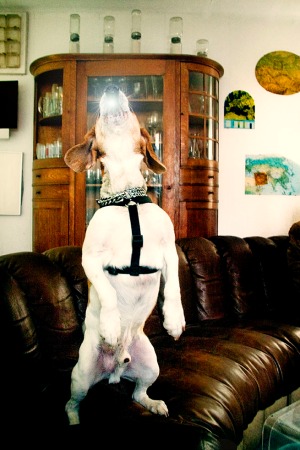 Breakfast at the Sherlock Holmes Café in Baker Street
Breakfast at the Sherlock Holmes Café in Baker Street
Click to enlarge holmessweetholmesedly
As William Somerset Maugham once said: «The best way to eat in the UK is to have breakfast three times a day» for our staff-photographer a Full English Breakfast is surely the best way to give his creativity all the goodness and strength he needs for a great and successful day. Honouring this stunning British novelist and short-story writer Andreas Baier decided to find out more about the differences between to eat breakfast and to be breakfast. Consequently, he went a little bit crazy for you:
 Prince Edward Theater in Soho
Prince Edward Theater in Soho
When in doubt where to have breakfast best then you better go to Soho which is, in such a case, still the best place to be. Here you can choose between traditional Full English Breakfast at the Old Compton Café; a great, pardon, Petit Déjeuner à Maison Bertaux in Greek Street, opposite Café Bohème where your breakfast will come along with real French croissants (from Maison Bertaux), butter, strawberry jam – and a jazz band. Or do you like it more Italian? Go to Bar Italia in Frith Street. If necessary this bar brings you through the whole night as well – and, not to forget, the Britsh band Pulp also wrote a song about it called, of course, Bar Italia. Here you can inform yourself about all restaurants and clubs on Old Compton Street.
 Motorhaubenfrühstück
Motorhaubenfrühstück
A cabby in front of the Old Compton Café uses his Evening Standard Cab as a table to make sure enjoying his traditional Full English Breakfast as flexible as even possible.
When already in Frith Street you should definitely consider checking in at the Hazlitt’s (built 1718) in order to speak to Mrs. Millet. She’s got two large breasts which let you sleep comfortably and an amazingly huge bathtub for you and your holy beloved breakfast. Celebrate it! Make sure you have opened the window so you can watch people working opposite in their first floor offices while you are relaxingly breakfasting…
 At the Hazlitt’s in Frith Street Mrs Millet offers you the largest bathtub you probably might have ever seen in a hotel’s bathroom.
At the Hazlitt’s in Frith Street Mrs Millet offers you the largest bathtub you probably might have ever seen in a hotel’s bathroom.
Well, for the «hardcore fraction» there is also an original 1950s American Diner called Ed’s. But be careful, not only their milkshakes are life threateningly sized.

The Old Compton’s Café offers a 23 hour service. Only between 5:00 and 6:00 am they close the doors and you can watch staff-members cleaning the café.

A group of young people having their third breakfast outside of Old Compton Café.

What most people do not know is that midnight hours make creative minds very productive. Just listen to what this young lady says to his boyfriend-in-future:
I Sent You My Love
«I sent you my love
I sent you my tears
so high up above
without any fears
without any lipsticks
but filled up with hip tricks
so clean and so funny
to beam up the bunny –
a dream and so yummy –
…just reading emotions…
Your leading proportions
are feeding the oceans
of mankind minds.
Part of the alliance:
your eyes, your mouth, your sense
and there is no excuse and there is no defence.
You’ve blinded me with science
and bounded me to the lion’s fence.
For any pence I’ve ever earned
and any trends I’ve never learned
I will buy you a castle build on clouds
until it shouts: ‘bean sprouts…’
You are gorgeous and delicious
like horseback riding fishes
and many other dishes
which make me superstitious
having met you once that day
when rain and sun were on the run,
when, hey, you know it better:
I received your magic letter!
So here I am, it’s my return,
just let’s the fire burn, burn, burn…»
As we just pointed out: The Old Compton Café is always a great place to be. And by the Milkyway: Old Compton’s bean spouts sandwiches are simply the best. Even Queen Mum enjoyed them from time to time. So, just give yourself a kick – and a real good go…
 Simpson’s-in-the-Strand
Simpson’s-in-the-Strand
Leaving Soho for a while we now visit Simpson’s-in-the-Strand; a place where ties and jackets must be worn; a place where The Ten Deadly Sins are the ultimate Must To Be Eaten; a place where you will immediately impress your guests coming from the continental side of life with a serious amount of British lifestyle clichés. The Ten Deadly Sins are nutritious in a way that you can easily cancel lunch and diner for the rest of the day. If you examine the price purely you might think to having found out why the ten sins are specified with deadly but if you are willing to recognise the fact that after their consumption you will receive a prime minister’s call who desperately wishes to be visited by you over the weekend, only one correct judgement can be made: the cost for Simpson’s The Ten Deadly Sins are nothing but a bargain.
The Ten Deadly Sins are: baked kidney beans, a lamb’s kidney, baked tomatoes, a cumberland sausage, fried mushrooms, freshly squeezed orange juice, some scrambled eggs, streaky and back bacon, black pudding, toast and marmalade as well as tea from your favourite colony.

Simpson’s-in-the-Strand is one of London’s oldest traditional English restaurants. Situated in the Strand, it is part of the Savoy Buildings, which also contain one of the world’s most famous hotels, the Savoy. When the first Michelin Guide to England was published in 1974, no UK restaurant was judged worthy of the maximum three stars, or even two, but Simpson’s was one of nine London restaurants, including Le Gavroche, awarded a star. In 1984 Simpson’s dropped its rule forbidding women from using the panelled street-level dining-room at lunchtime. Ten years later Simpson’s-in-the-Strand started to offer The Ten Deadly Sins.
Leaving Simpson’s In The Strand we suddenly feel being forced walking to Hyde Park’s Speaker’s Corner «only» to burn down some extra deadly calories. The preacher Orange Fruit Johns’ sermon is about healthy breakfast habits and attitudes – and regularly visited by hundreds of health food junkies and tree-huggers:
 Speaker’s Corner
Speaker’s Corner
He strongly recommends pigeons for breakfast because they are known as seed and fruit eaters. Orange Fruit Johns says: «If we eat pigeons that eat seeds and fruits so we eat seeds and fruits as well.» And he adds: «Seeds and fruits which are so tremendously light and weightless that they can fly through the air by themselves because they have proven to know how to influence pigeons. If you eat pigeons on a daily bases you will also improve you IQ significantly».

Does it work? Will there be human pigeon digesters around? Of course – as this visual proof demonstrates: First the pigeons are getting fed with seeds and then, in a moment of mental diversity, they get caught and eaten on the spot. Can you see how calm and satisfied this group of pigeon eaters look? Of course you can.

Let’s have a closer look at Full English Breakfast’s ingredients to analyse what makes them so successfully travelling around the globe. The cornerstones of it are, without doubt, our one and only baked beans:
 Baked beans on a toast are also known as Skinheads On A Raft.
Baked beans on a toast are also known as Skinheads On A Raft.
Brickfist For Breakfast
Between a brickfist and a breakfast there are no real differences. Preferably we should say that the one cannot really live without the other. A brickfist is mainly for people who do not want to eat. So, in these cases the brickfist always prepares the way for the breakfast. (Hunter S. Thompson)
 Un Ungentlemanly Act
Un Ungentlemanly Act
Giving vegetably based breakfast cereals such as harmless baked beans nasty names is equal to spreading violence all over our planet. As a result of that even peacefully living baked beans suddenly start to rumble around meaning to destroy everything – even it is their very own base of existence. Our staff-photographer Andreas Baier was very surprised when noticing what happens when ordinary baked beans drive nuts. Consequently, he calls his flashlight painting «Un Ungentlemanly Act». Fortunately, since the year 2005 a new law by British government, best known as «Law of Legal Advice For Proper Breakfast Protection» (LOBP), helps our society to stay away from doing stupid things to things we love or urgently need to survive.
 Two slices of Black Pudding on their way to wherever…
Two slices of Black Pudding on their way to wherever…
Are these two slices of black pudding on the run, ensuring not to accidentally meat a group of uncivilised beaked beans in the dark? This is certainly possible. Are these two slices of black pudding on their way to wherever? This is certainly possible. Most likely, however, is that they are just living and behaving as two normal slices of black pudding, so to speak.
 Hush hour
Hush hour
During early morning hours cabbies are hungrily hunting for black pudding which hushes over the street in the background of this very same photograph.
 Negotiation between a generously sliced piece of black pudding and a cab driver
Negotiation between a generously sliced piece of black pudding and a cab driver
Human slices of black pudding are clever enough to know that they cannot hide forever. Here you see a slice of special business black pudding negotiating the fee before handing himself over to his hungry client. A classic win-win-situation.
 The Standing Breakfast Sausages
The Standing Breakfast Sausages
The ultimate strongmaker, however, are breakfast sausages. They know who you are and what you need most: a huge portion of self-confidence. They are as solid as a rock and their flavour will let you look spicy, tasty and good to any boss that might be right about to decide whether to or not to promote you. Our advice: have plenty of them and be kind to pigs.
 Traditional Oxbridge Race
Traditional Oxbridge Race
At Hammersmith-Bridge even spectators only have time for a quick and fluid breakfast: beer. Oxbridgers are traditionally trying to find out which of their two teams will be faster(ly) racing with their boats over the Thames. Do not laugh – it’s a serious business: here careers will be either made or destroyed before they have ever been started.

«Show me the way to the next whisky bar. – Sorry, no can do, sorry, no can do. – But tell me, where will I find V&A’s Jazz Brunch – Certainly can do, certainly can do»:
 Jazz Brunch at the Victoria & Albert Museum
Jazz Brunch at the Victoria & Albert Museum
 Jazz Brunch at the Victoria & Albert Museum
Jazz Brunch at the Victoria & Albert Museum
 Jazz Brunch at the Victoria & Albert Museum
Jazz Brunch at the Victoria & Albert Museum
Jazz music makes policy news more acceptable.
 Jazz Brunch at the Victoria & Albert Museum
Jazz Brunch at the Victoria & Albert Museum
Without jazz music no one would understand messages coming along with unique visual side-effects.(Understand?) Here in this case love is the message and the message is love unless it says that a minister joins the FF when willing to climbing bittersweetly up the stairs while wanting to make history in an honourable and most meaningful way.
 Covent Garden
Covent Garden
Outside it is still raining; this time cats, dogs and hailstones at Covent Garden. About to catch a cold? Just grab an apple to provide you with a huge portion of vitamin C.
 Hopelessly Tomato In Line
Hopelessly Tomato In Line
 Planet Hollywood
Planet Hollywood
At The Haymarket: «Planet Hollywood» which is owned by Arnold Schwarzenegger, Sylvester Stalone, Demi Moore, Jackie Chan and Bruce Willis offers you breakfast, lunch and dinner surrounded by requisites that were part in Hollywood and other major movies such as James Bond for example. The entrance to one of several dining rooms is a gangway that appeared in Moonraker.
 Secret Curtain Signals
Secret Curtain Signals
The victorian way to communicate secretly with neighbors.
At Highgate: the curtain signal «left down, closed, left down» on the second floor means that freshly squeezed labours are being served for breakfast. The message coming from first floor, however, likes to encourage young women with intellectual capabilities to ring the doorbell initially. But the combination of both signal messages means: «Honey, I’m taking the dogs out. I’ll be back soon». Here’s the proof:

A perfect example of what an excentric lifestyle looks like: taking the dogs out in hush puppies.
This also may evoke the question: What does a real labour breakfast look like, and where and when does it take place? The answer: at 4:15 am, close to Smithfield Meat Market where its porters are having their first cigarette plus a mug of tea:
 Labour breakfast starts at 4:15 am at Smithfield Meat Market
Labour breakfast starts at 4:15 am at Smithfield Meat Market
 A generously filled mug of tea is what meat porters keeps alive – and going.
A generously filled mug of tea is what meat porters keeps alive – and going.
 An they have a bun of meat as well.
An they have a bun of meat as well.

From time to time Damien Hirst shows up and shares his labour breakfast with the meat porters although the famous artist looks very tired.

The bakery Benjys provides a lot of cafés in Soho with freshly made breads of various kinds. They start to work when all others are still asleep.

Believe it or not: even Pizza Hut delivers its products for breakfast.

Thanks to the magic power of freshly squeezed orange juice: happy in the morning, happy the whole day – the secret smile of Walter Fitty.
 Soho Brasserie opposite Old Compton Café
Soho Brasserie opposite Old Compton Café
Happy in the morning, happy the whole day – Part II.
 Shelter for Cabbies
Shelter for Cabbies
Initially installed in the 19th century by Queen Victoria, from former 40 shelters only a dozen made it into today’s time. Shelters are green painted wooden cottages in which cab drivers will be served with their meals, breakfast included.
 The author and journalist John McCarthy on his promotion tour.
The author and journalist John McCarthy on his promotion tour.
The author John McCarthy on his tour to promote Some Other Rainbow, a book about a remarkable account of courage, endurance, hope and love: on 17 April 1986 John McCarthy was kidnapped in Beirut. For the next five years he was cut off from everything and everybody he knew and loved, from family, friends, and, perhaps above all, from Jill Morrell, the girl he was going to marry.
For five years, John McCarthy had to endure the deprivation – both physical and psychological – of captivity; the filth and squalor of the cells in which he was kept; the agony of isolation and repeated self-examination; and the pain of ignorance, of not knowing if those he loved even realized he was alive. And there was another problem: his daily breakfast wasn’t exactly the way as expected … Read the whole thing here.

These cab drivers got plenty of time. They are not in a hurry. Not at all. They already read their newspapers – and they will do it again and again. They are happy to live a similar life to the ones of the guys who are testimonials in these frozen-time-Jack-Daniel’s-ads and who made them world-famous. Here they love to wait until their personal buffalo gets shot à la minute and their charcoal grilled sirloin steak will be served in a perfect medium manner.

Great British Breakfast at the Savoy.

On Portobello Road: Fine hardware for a perfectly designed breakfast table. Finally, the probably best reviews on contemporary London breakfasts you will find on London Review of Breakfasts. It’s very informative and delicious, at least it’s very rich.

We were intensively thinking about what this photograph’s link to breakfast could be. Finally, we came to the conclusion that there isn’t any – which makes this image a perfect finisher. And since we think that this great picture could be the fundament of a stunning ad for Pfizer’s Viagra it is a brilliant opener as well. But that’s a complete different story, isn’t it?
***
Some of these photographs were originally printed in the German magazine «GLOBO» in the year 1994. Here, for the first time, they are published to the full providing you with a proper insight into all the days which were those, my friend…






***About the author***
Andreas Baier was born in Garmisch-Partenkirchen which is a small town in bavaria, the homeland of lederhosen – and so it’s only natural that he loves Scotland. For him it was more than clear to combine two of his favourite breakfast subjects in one picture: Can you see how Nessi enjoys swimming in mashed potatoes?
 Nessi in Garmisch-Partenkirchen
Nessi in Garmisch-Partenkirchen
***
Sensitive topic. Therefore comments off.
***
Tags: Baked Beans, Black Pudding, Breakfast, Frühstück, Full English Breakfast, Great Britrain, Hazlitt's, london, Savoy, Simpson's-in-the-Strand, Soho, UK
 Fotos von Andreas Baier
Fotos von Andreas Baier
 Title: Rothko at Guggenheim
Title: Rothko at Guggenheim Click to enlarge yoshikaroshiedly
Click to enlarge yoshikaroshiedly Fotos von Andreas Baier
Fotos von Andreas Baier

 Click to enlarge horsebackridingly
Click to enlarge horsebackridingly



 Photographs by Andreas Baier
Photographs by Andreas Baier





 Foto von Andreas Baier
Foto von Andreas Baier Hommage à Joseph Beuys
Hommage à Joseph Beuys Hommage à Joseph Beuys
Hommage à Joseph Beuys Hommage à Joseph Beuys
Hommage à Joseph Beuys Hommage à Joseph Beuys
Hommage à Joseph Beuys Fotos von Andreas Baier
Fotos von Andreas Baier Walter Stöhrer im Mannheimer Kunstverein (1981)
Walter Stöhrer im Mannheimer Kunstverein (1981) Erik Spiekermann photographed by Andreas Baier
Erik Spiekermann photographed by Andreas Baier Erik Spiekermann photographed by Andreas Baier
Erik Spiekermann photographed by Andreas Baier Banana Armada – flashlight painting by Andreas Baier
Banana Armada – flashlight painting by Andreas Baier «Stone Newspaper» (1992) by Kubach-Wilmsen-Team
«Stone Newspaper» (1992) by Kubach-Wilmsen-Team «Stone Book Cardinal» (1986) by Kubach-Wilmsen-Team
«Stone Book Cardinal» (1986) by Kubach-Wilmsen-Team «Stone Book Amazonas» (1991) by Kubach-Wilmsen-Team
«Stone Book Amazonas» (1991) by Kubach-Wilmsen-Team Click to enlarge fascinatingedly
Click to enlarge fascinatingedly Nicholas DeVore III et David H. Lyman dans la Camargue pendant les Rencontres Internationales de la Photographie à Arles
Nicholas DeVore III et David H. Lyman dans la Camargue pendant les Rencontres Internationales de la Photographie à Arles Click to enlarge ustinovedly
Click to enlarge ustinovedly «Two Golden Lions Enjoying Themselves» (1999) –
«Two Golden Lions Enjoying Themselves» (1999) – Click to enlarge microsoftly
Click to enlarge microsoftly Otto Herbert Hajek, Horst Ehmke und Ehefrau Katja Hajek während der Vernissage im Germanischen Nationalmuseum in Nürnberg
Otto Herbert Hajek, Horst Ehmke und Ehefrau Katja Hajek während der Vernissage im Germanischen Nationalmuseum in Nürnberg Hajek-Skulptur auf der Insel im Salzgitter-See
Hajek-Skulptur auf der Insel im Salzgitter-See Hajek-Skulptur auf der Insel im Salzgitter-See
Hajek-Skulptur auf der Insel im Salzgitter-See Skulptur von Katja Ka in Salzgitter-Thiede
Skulptur von Katja Ka in Salzgitter-Thiede Click to enlarge abstractedly
Click to enlarge abstractedly













 Click to enlarge beuysdly
Click to enlarge beuysdly Breakfast at the Sherlock Holmes Café in Baker Street
Breakfast at the Sherlock Holmes Café in Baker Street Prince Edward Theater in Soho
Prince Edward Theater in Soho Motorhaubenfrühstück
Motorhaubenfrühstück At the Hazlitt’s in Frith Street Mrs Millet offers you the largest bathtub you probably might have ever seen in a hotel’s bathroom.
At the Hazlitt’s in Frith Street Mrs Millet offers you the largest bathtub you probably might have ever seen in a hotel’s bathroom. 


 Simpson’s-in-the-Strand
Simpson’s-in-the-Strand
 Speaker’s Corner
Speaker’s Corner

 Baked beans on a toast are also known as Skinheads On A Raft.
Baked beans on a toast are also known as Skinheads On A Raft. Un Ungentlemanly Act
Un Ungentlemanly Act Two slices of Black Pudding on their way to wherever…
Two slices of Black Pudding on their way to wherever… Hush hour
Hush hour Negotiation between a generously sliced piece of black pudding and a cab driver
Negotiation between a generously sliced piece of black pudding and a cab driver The Standing Breakfast Sausages
The Standing Breakfast Sausages Traditional Oxbridge Race
Traditional Oxbridge Race
 Jazz Brunch at the Victoria & Albert Museum
Jazz Brunch at the Victoria & Albert Museum Jazz Brunch at the Victoria & Albert Museum
Jazz Brunch at the Victoria & Albert Museum Jazz Brunch at the Victoria & Albert Museum
Jazz Brunch at the Victoria & Albert Museum Jazz Brunch at the Victoria & Albert Museum
Jazz Brunch at the Victoria & Albert Museum Covent Garden
Covent Garden Hopelessly Tomato In Line
Hopelessly Tomato In Line Planet Hollywood
Planet Hollywood Secret Curtain Signals
Secret Curtain Signals
 Labour breakfast starts at 4:15 am at Smithfield Meat Market
Labour breakfast starts at 4:15 am at Smithfield Meat Market A generously filled mug of tea is what meat porters keeps alive – and going.
A generously filled mug of tea is what meat porters keeps alive – and going. An they have a bun of meat as well.
An they have a bun of meat as well.



 Soho Brasserie opposite Old Compton Café
Soho Brasserie opposite Old Compton Café Shelter for Cabbies
Shelter for Cabbies The author and journalist John McCarthy on his promotion tour.
The author and journalist John McCarthy on his promotion tour.









 Nessi in Garmisch-Partenkirchen
Nessi in Garmisch-Partenkirchen
You must be logged in to post a comment.